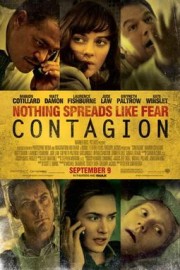Contagion
Rewatching Steven Soderbergh’s “Contagion” during the COVID-19 pandemic, I was more angry than I was fearful. Angry that our worst tendencies as humans have been exposed when other people’s lives are at stake. Angry that, in my country, we have leaders whom have weighed economic concerns, and decided that lives mean less. And angry that this film didn’t get the box-office attention it should have received, because if it had, maybe we as a society would have remembered some of the lessons this film has for us.
Soderbergh and his screenwriter, Scott Z. Burns, took great care in laying out a doomsday scenario for us in this film, where two infected parties lead to four, then 16, then 64, then 264, then we reach a pandemic that grinds society to a halt as scientists at the CDC and WHO try to nail down not only the biological elements of this virus, but where it originated, and how it spread. We will not learn the full truth of that until the very last moments before credits, and if they don’t feel eerily familiar to how COVID-19 started, you might be listening to the wrong news sources.
When things really got serious in the United States about COVID-19 in March, it’s kind of shocking how not panicked I was. I was concerned, and took social distancing, wearing masks, and self-isolation seriously, but you would think, a 42-year-old with a history of respiratory issues, who’s been on oxygen machines at home, who was on a ventilator in 2007, and knows he has damaged lung would be more scared shitless about a disease he is high-risk for. My wife, who’s diabetic, had that covered for both us, but I cannot blame her for feeling that way. She was thinking not just of herself, but me, my mother, and her parents. We have a lot of high-risk people in our circle, and even now, as things have begun to open, we’ve been hesitant when it comes to going out except to our family’s houses, and on “essential trips” for food and other supplies. Still, we’ve done a bit more, but we remain to take things seriously. (I don’t know when I’ll feel comfortable eating out again.) We’re very much like Matt Damon’s character in “Contagion,” except we didn’t need our wife (Gwyneth Paltrow, one of the first patients) or son to die to take the steps we took. Even if it seemed extreme, it was ultimately for not only our good, but the good of those we cared about, as we could be asymptomatic carriers. I didn’t need “Contagion” to realize that, but it was good to have a reminder of why that was so important as we see this unknown virus in the film spread exponentially.
One of the things we become so acutely aware of in “Contagion” is points of contact. It’s not just the typical signs of sickness that can spread something like the disease in this film. A credit card being swiped. An arm around the shoulder. Pushing your chips in at a casino. Wiping your hands on your apron rather than washing them. It’s a deliberate choice on Soderbergh’s part that should absolutely scare us shitless while watching the film, to see how easily something can be passed from one person to another. Those last few moments I talked about earlier are about giving us context for how easily, and unexpectedly, something that can decimate humanity, and bring us to our needs, can be started, but it’s the close-ups Soderbergh does throughout the film that should terrify us more, and make us aware of how the littlest things can be deadly, and how, sometimes, doing one thing different might mean life and death for not just you, but others.
“Contagion” might be construed as “liberal Hollywood” propaganda if we were not seeing so much of what’s happening in the film play out in real life. Jude Law’s Alan Krumwiede, a blogger who is an Alex Jones-type in spreading fear and conspiracy also is peddling a “remedy” to the disease in the film not unlike how people pushed Hydroxychloroquine as a “miracle cure” for COVID-19; he claims to have cured himself with an unproven homeopathic remedy, which he makes millions off of. We see the inner workings of how the CDC and WHO, along with other scientists, track the disease, sometimes putting themselves in great danger to do so. This is a movie where we can expect some well-known actors, and characters we come to empathize with, to die; this is a procedural examining a subject from all sides, warts and all, not unlike Soderbergh’s “Traffic.” That it keeps us glued to the screen every step of the way, and we feel as though we’ve been given a big meal of an experience, shows that Soderbergh’s eye for storytelling and digging deep into a subject has remained unabated over the years. “Contagion” is one of his best films, and one that plays terrifyingly true nowadays, in ways we couldn’t fathom when it came out.










